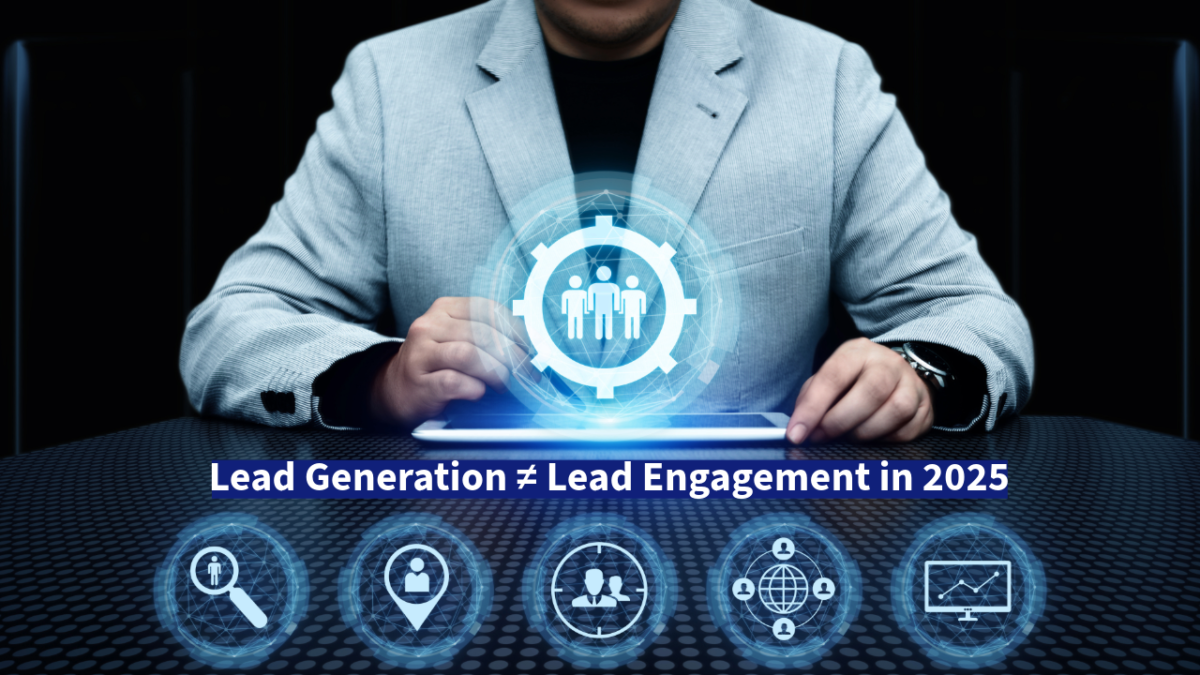Lead Generation ≠ Lead Engagement in 2025: The Missing Piece in Enterprise Sales Growth
Table of Contents
In enterprise sales, generating leads is just the first step. Without proper engagement, these leads often fail to convert. As we enter 2025, businesses must shift focus from simply capturing leads to effectively nurturing them. This article explores the critical distinction between lead generation and lead engagement, providing actionable insights for B2B enterprises.
Defining Lead Generation and Lead Engagement
What is Lead Generation?
Lead generation involves attracting and capturing potential customers’ interest through various marketing efforts, such as:
- Content marketing (e.g., whitepapers, case studies)
- Webinars and trade shows targeting decision-makers
- Advertising campaigns (e.g., LinkedIn ads, Google Ads)
For example, a software company may offer a free trial in exchange for contact information. While this generates leads, it doesn’t ensure they are sales-ready.
To improve lead quality and follow-up accuracy, tools like Leadfeeder allow businesses to track website visitors, score their intent based on behavior, and prioritize the most sales-ready opportunities.
What is Lead Engagement?
Lead engagement (or nurturing) is the process of building relationships with leads to guide them through the sales funnel. This involves:
- Personalized communication via emails, phone calls, and chatbots
- Educational content to address specific pain points
- Follow-ups and multi-channel engagement to maintain interest
Example: A B2B SaaS provider follows up with leads through automated emails, personalized demo invitations, and LinkedIn outreach to keep them engaged.
The Gap in Enterprise Sales: Why Lead Generation Falls Short
Challenges of Lead-Only Focus
Enterprise sales cycles range from 6 to 18 months, involve multiple decision-makers, and often exceed $100,000 per deal (Forrester: B2B Sales Cycle Length). However, without engagement, businesses face key challenges:
- High volume, low quality: Many generated leads are not sales-ready.
- Leads go cold: Without nurturing, prospects lose interest.
- Missed stakeholders: Engaging only one contact might not be enough to close a deal.
According to Forrester, 80% of B2B leads never convert due to lack of engagement.
The Role of Lead Engagement in Enterprise Sales
Why Lead Engagement Matters
- Building Trust: Consistent engagement through webinars, case studies, and follow-ups fosters credibility.
- Understanding Customer Needs: Engaging leads allows businesses to tailor solutions to specific pain points.
- Managing Multiple Stakeholders: Enterprise deals often involve IT, finance, and operations; engaging all decision-makers ensures smoother conversions.
Research Insight: Zendesk: Lead Management Best Practices highlights that lead nurturing is essential, likening it to a gardener tending to plants.
Strategies for Effective Lead Engagement
1. Automated Lead Nurturing
- Use email workflows to deliver relevant content based on lead behavior.
- Example: Tech giant improved productivity by automating lead nurturing with GO MO Group.
2. Personalized Communication
- Leverage AI to customize messages (e.g., Need help with ERP integration?).
- Campaign Monitor: Personalization boosts engagement by 37%.
3. Multi-Channel Engagement
- Combine email, LinkedIn, phone calls, and in-person meetings.
- Example: Auto Giant improved engagement across 6,000 dealerships using iTMunchcontent syndication.
4. Lead Scoring and Qualification
- Score leads based on interaction levels to prioritize high-value prospects.
- SalesWings: Helped Princeton Review boost deal closures by 160%, adding $170,000 in revenue.
5. AI-Powered Tools for 24/7 Engagement
- AI chatbots qualify and nurture leads in real time.
- Salesforce: 80% of B2B buyers expect real-time responses.
Case Studies: Lead Engagement Driving Enterprise Growth
| Company | Source | Challenge | Engagement Strategy | Results |
| LTIMindtree (GO MO Group) | gomogroup.com | Improving sales-qualified leads for Dell | Email + telemarketing outreach | Boosted pipeline quality |
| Tech Firm (iTMunch) | iTMunch.com | Engaging mid-market enterprises for SaaS adoption | AI chatbots + multi-channel follow-ups | 30% increase in lead-to-demo conversions |
| Manufacturing Co. (Whitepapers Online) | whitepapersonline.com | Converting whitepaper downloads into deals | Personalized email nurturing | 20% lift in qualified leads, $150K in contracts |
Case Study Highlights
- LTIMindtree: Combined email and telemarketing to nurture leads for Dell’s IT solutions, leading to higher quality leads.
- Tech Firm: AI chatbots and LinkedIn follow-ups increased lead-to-demo conversions by 30%.
- Manufacturing Co.: Personalized email engagement post-whitepaper download resulted in $150K in new deals.
Conclusion & Call to Action
In summary, while lead generation is essential for attracting prospects, lead engagement is the critical step that drives enterprise sales growth. By implementing strategies like automated nurturing, personalized communication, and AI-powered tools, businesses can build relationships, understand needs, and convert leads effectively. The case studies of Bonito Designs, Bajaj Auto, and Princeton Review underscore the impact of engagement in complex B2B environments.
For readers, consider reviewing your current lead engagement processes. Start by testing an AI chatbot for real-time interactions or mapping a structured customer journey. Share your experiences or challenges in the comments, and let’s explore how to unlock enterprise sales growth together in 2025.
Supercharge growth with quality leads! Fill out the form for a personalized plan and an exclusive offer, crafted for your business success.





